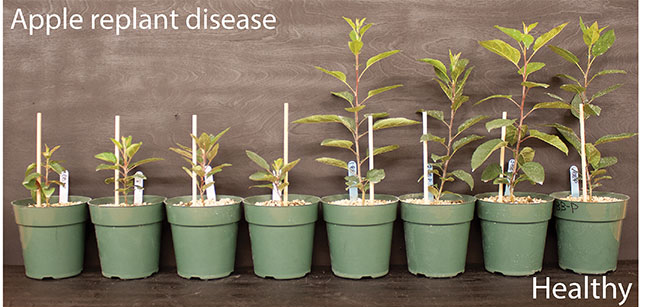
Features
Pests
Fighting plant disease from the inside
Meet fungal endophytes – the newest biological control agent on the block.
June 12, 2023 By Julienne Isaacs
 Currently, Ali’s group is working on a couple of projects identifying and characterizing endophytes for deployment against plant pathogens – for example, in apple trees.
Image courtesy of Shawkat Ali, AAFC.
Currently, Ali’s group is working on a couple of projects identifying and characterizing endophytes for deployment against plant pathogens – for example, in apple trees.
Image courtesy of Shawkat Ali, AAFC. An endophyte is an organism – typically bacteria or fungi – that lives inside a plant for part of its life cycle. Every plant has microbial endophytes.
“The interactions between micro-organisms and host plants can be neutral, harmful or have beneficial effects on both organisms,” says Shawkat Ali, a research scientist based at Agriculture and Agri-Food Canada’s Kentville Research and Development Centre in Nova Scotia.
“Fungal endophytes… [don’t cause] any damage or disease symptoms in their host organism most of the time,” says Ali. In fact, he says, they’re often beneficial.
But what, exactly, do they do for plants?
In a recent review paper, Ali and his co-authors show that fungal endophytes can directly protect plants against pathogens. They can also help them indirectly, by making plants more resilient to pest damage, improving water and nutrient availability and remediating abiotic stresses, including drought, salinity, flooding and toxic chemicals in the environment.
“These endophytic micro-organisms provide protection against pests, insects, pathogens and predators through different mechanisms,” he says.
Ali’s research group is interested in how endophytes in healthy plants can be harnessed to control harmful pathogens in lieu of chemical fungicides.
It’s an increasingly important avenue of investigation, he argues, in light of recent restrictions on chemical inputs in Canada and around the world.
Commercialized products
In fact, some bacterial and fungal endophytes have been commercialized for use against crop pests in countries around the world, including the United States and Australia.
Last year, Corteva Agriscience announced an agreement with the microbiological company Symborg to distribute the latter’s endophytic bacterium Methylobacterium symbioticum product, which helps plants capture nitrogen from the atmosphere.
Trichoderma harzianum strain T-22, the active ingredient in Trianum WG biological fungicide and Trianum G biological fungicide, has been registered by Health Canada’s Pest Management Regulatory Agency (PMRA) for the suppression of soil-borne pathogens that cause root diseases on greenhouse crops, field crops, greenhouse ornamentals and turf, says Ali.
Bacillus amyloliquefaciens strain F727 has also been registered by the PMRA for use in a variety of crops, including canola, sunflower and potatoes, to control or suppress various diseases. Another company, Adaptive Symbiotic Technologies, commercialized an endophytic fungi product called BioEnsure in 2017.
But endophytic products like these are not yet in common use in Canada.
How do they work?
How do “plant-friendly” endophytes work?
“Plant-friendly endophytes produce and secrete secondary metabolites/biochemicals that suppress/reduce the negative effects from plant pathogens, including volatile compounds that are able to suppress pathogen growth,” writes Ali in the publication.
Other endophytes protect the host plant by triggering plant defense mechanisms, he says, or by secreting antifungal or antibacterial compounds. Some even eat other fungi.
“Endophytes also directly compete with the host pathogens for space and nutrients,” Ali points out. Several endophytes also have plant growth-promoting properties that help the host plant get stronger.
Ali says endophytes can be added to “carrier materials,” such as vermiculite, expanded clay, sand and peat, used as a seed treatment, or even applied in-field as a spray.
“Endophytes that colonize the roots can be applied as spores formulated in powder,” Ali adds. “They can also be applied as lyophilized [freeze-dried] spores or in liquid formulation, as seed covers or by dipping the seedling plant roots in an endophyte suspension before planting,” he says.
Ali’s idea is that endophytes could be applied in groups versus singly, so as to combine beneficial properties in one application.
“A broader approach can involve microbiome transplantation or the use of soil amendments and root exudates to attract and maintain beneficial microbiomes,” he says.
Currently, Ali’s group is working on a couple of projects identifying and characterizing endophytes for deployment against plant pathogens.
In one project, the team isolated more than 100 fungal endophytes from the roots of healthy apple trees. Then, they completed in vitro competition assays to assess the endophytes’ antifungal capability against apple replant disease-causing pathogens. The next step is to carry that work into a greenhouse setting, says Ali.
Plant microbiota are incredibly complex, and researchers have barely scratched the surface. Much more research is needed to understand the ways in which fungal endophytes might play a role in the field, and the impacts on plant and soil microbiota of endophyte application.
The paper concludes, “The future of agriculture will involve the increasing consideration and integration of the plant microbiome in pest and disease management strategies and, as crucial members of the plant microbiome, fungal endophytes will play a leading role.”